Navigating the plethora of available product discovery solutions can be a daunting task. You’re eager to efficiently sift through ideas and identify promising opportunities, but pinpointing the ideal tool remains a challenge. Fear not! In this article, drawing from my extensive experience using various discovery tools within expansive projects and teams, I aim to simplify your decision-making process by spotlighting the foremost product discovery tools.
“For development teams seeking optimal solutions, this software is tailored to your requirements,” shares industry expert John Doe. It assists in unearthing, validating, and gauging the potential impact of novel product concepts, refining your comprehension of what defines a minimum viable product (MVP) for your target audience.
Statistically, 70% of development teams face challenges in product discovery, emphasizing the significance of choosing the right tool to navigate this landscape efficiently. Leveraging my comprehensive exploration of these tools, I’m here to guide you towards those that seamlessly align with your specific needs.
What are Product Discovery Tools?
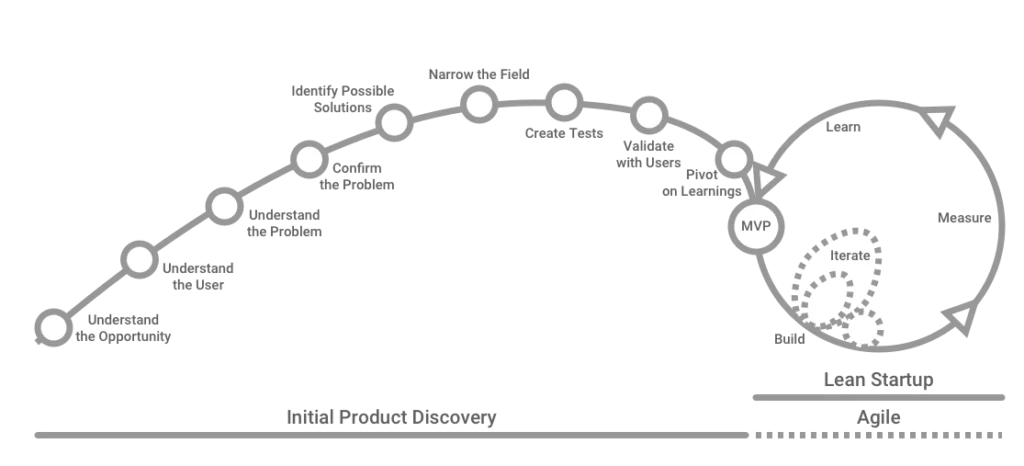
Source: PDMethods
Product discovery tools encompass software solutions designed to identify, analyze, and validate potential product opportunities. By amalgamating user data, prioritizing features, delineating product roadmaps, facilitating user testing, and enabling strategic decision-making, these tools serve a multifaceted role.
Beyond merely aiding the product discovery process, they are pivotal in honing your backlog, translating abstract product ideas into tangible user stories with a compelling value proposition. Embraced by product managers, designers, and developers, these tools usher in a more data-driven approach to launching innovative product concepts.
Benefits of Product Discovery Tools:
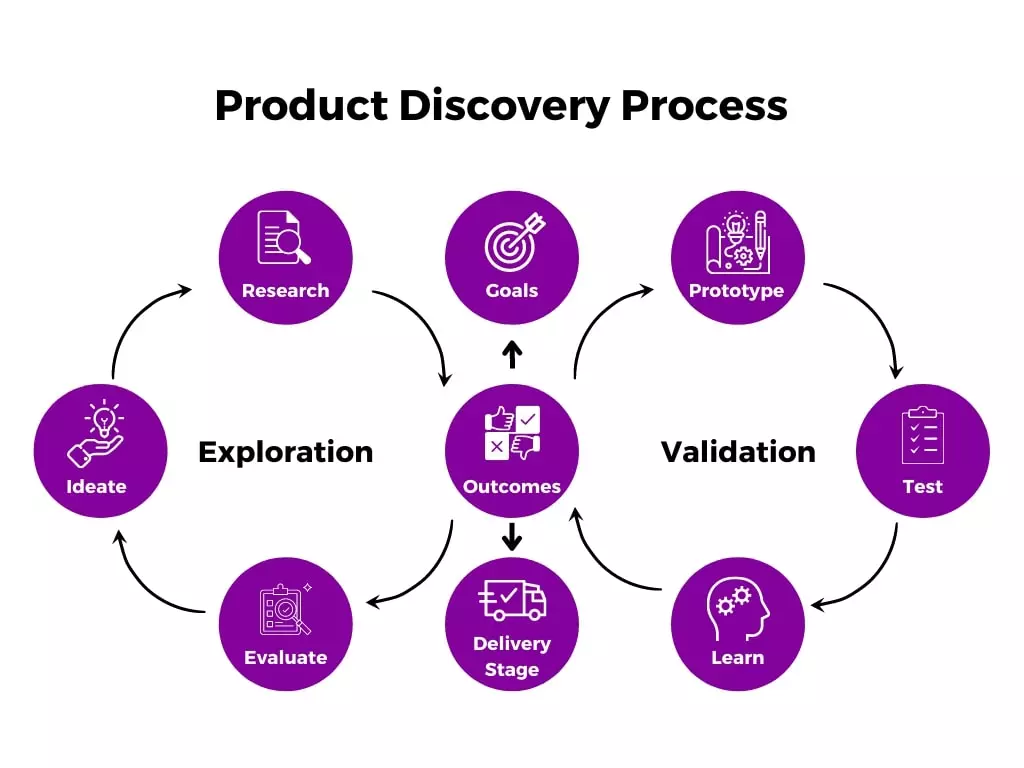
- Enhanced User Understanding: These tools help in gaining deep insights into user behaviors, preferences, and pain points. By understanding users better, businesses can tailor products to meet their needs effectively.
- Streamlined Product Development: Product discovery tools assist in prioritizing features, ideas, and improvements based on user feedback and data analysis. This streamlines the product development process by focusing on what matters most to users.
- Improved Decision-Making: These tools provide data-driven insights that aid in making informed decisions regarding product features, enhancements, and overall strategy. They help teams decide which functionalities or improvements will deliver the most value.
- Agile Development Approach: By allowing iterative testing and user feedback incorporation, these tools align with agile development methodologies, enabling continuous improvement and iteration.
- Enhanced User Experience (UX): By tracking user behavior, conducting usability tests, and collecting feedback, these tools contribute to creating a better user experience, ensuring that products are intuitive and user-friendly.
- Innovation and Idea Generation: Product discovery tools foster creativity and innovation by encouraging teams to brainstorm and ideate around user needs and pain points. They help in generating new product ideas and solutions.
- Reduced Time-to-Market: By efficiently prioritizing features and functionalities, these tools optimize the product development lifecycle, reducing time spent on irrelevant or less valuable aspects and accelerating the time-to-market for new products or updates.
- Increased ROI and Customer Satisfaction: By focusing on user-centric design and aligning features with user needs, organizations can increase customer satisfaction, leading to higher user retention rates and improved return on investment (ROI).
- Cross-Functional Collaboration: Product discovery tools encourage collaboration among various teams (design, development, marketing, etc.) by providing a centralized platform for sharing insights and working together toward common objectives.
Learn about off-page SEO here.
Top Product Discovery Tools:
1. Airtable
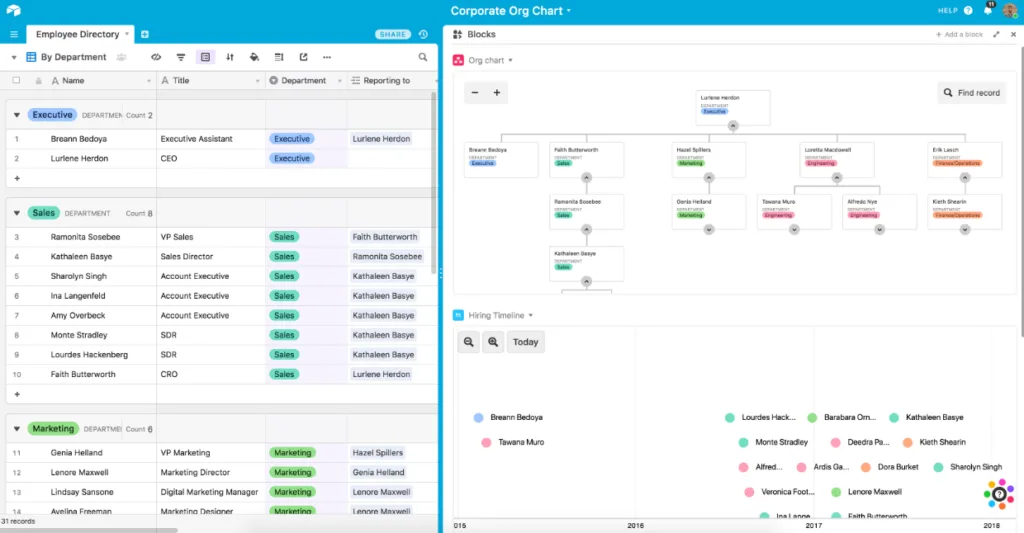
Airtable stands out as a cloud-based software platform that harmonizes the functionalities of a spreadsheet with the prowess of a database. Its versatility spans from proficient project planning to meticulous inventory tracking, rendering it a versatile tool for comprehensive product management.
The distinctive allure of Airtable lies in its remarkable fusion of flexibility and robust database capabilities. Unlike its counterparts, this tool presents a gamut of templates and views – grid, calendar, kanban, gallery, and form – tailored for managing and visualizing product data. It’s deemed ideal for those seeking adaptable product management solutions, given its knack for accommodating diverse workflows and requisites.
Key Features & Integrations:
Airtable boasts powerful attributes such as interlinking related content, synchronized data across bases, and automated functionalities for streamlining repetitive tasks. Its repertoire also encompasses robust reporting mechanisms for monitoring progress and detecting trends. Moreover, the platform seamlessly integrates with an extensive array of platforms, including Slack, Google Workspace, Microsoft Teams, GitHub, among others.
Pricing Structure:
Starting at $10/user/month (billed annually) or $12/user/month for monthly billing.
Pros:
- Adaptable to varying use cases with its flexible views and templates
- Offers robust reporting and automation functionalities
- Supports extensive integrations with diverse tools
Cons:
- Complexity might pose a challenge for non-technical users
- Limited built-in data validation features
- The free tier comes with notable limitations
2. Usabilla
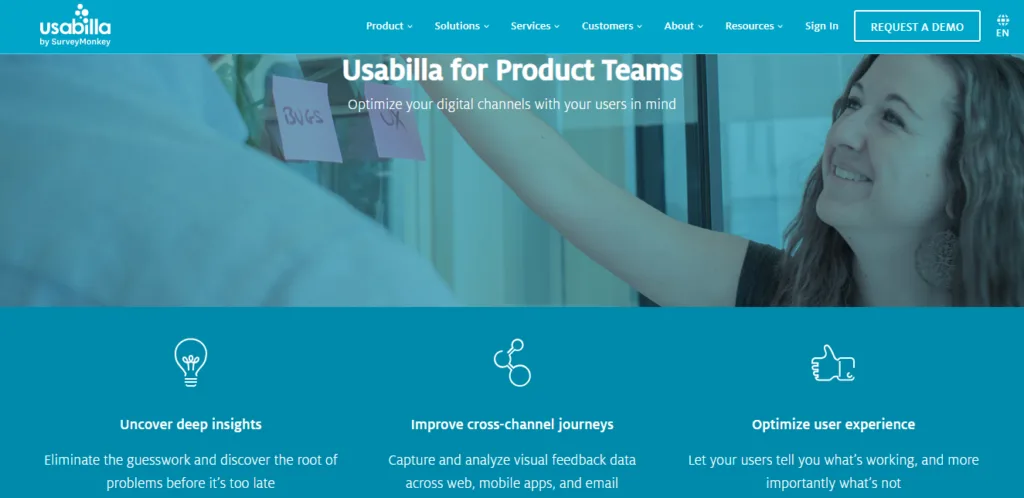
Usabilla stands as a formidable tool empowering businesses to comprehend and enhance the user experience across websites, apps, and emails. Its comprehensive feedback mechanism serves as a cornerstone for informed decision-making grounded in user perspectives.
The exceptional prowess of Usabilla in capturing real-time user feedback distinguishes it. This capability enables swift and efficient enhancements to the user experience, setting it apart from other tools. Its visually intuitive feedback forms and surveys contribute significantly to its standout feature set.
Key Features & Integrations:
Usabilla offers a suite of features including targeted surveys, visual feedback capture, and in-depth analytics reports, enabling businesses to gather rich insights for improving UX. Its integration capabilities span across various platforms like Slack, Jira, Trello, Zendesk, and Salesforce, facilitating streamlined workflows.
Pricing Structure:
Pricing for Usabilla is available upon request.
Pros:
- Offers detailed, real-time user feedback
- Rich analytics for profound insights into user experience
- Extensive integrations to streamline workflows
Cons:
- Lack of transparent pricing
- Customization options may have limitations
- Initial setup may require technical expertise
3. Productboard
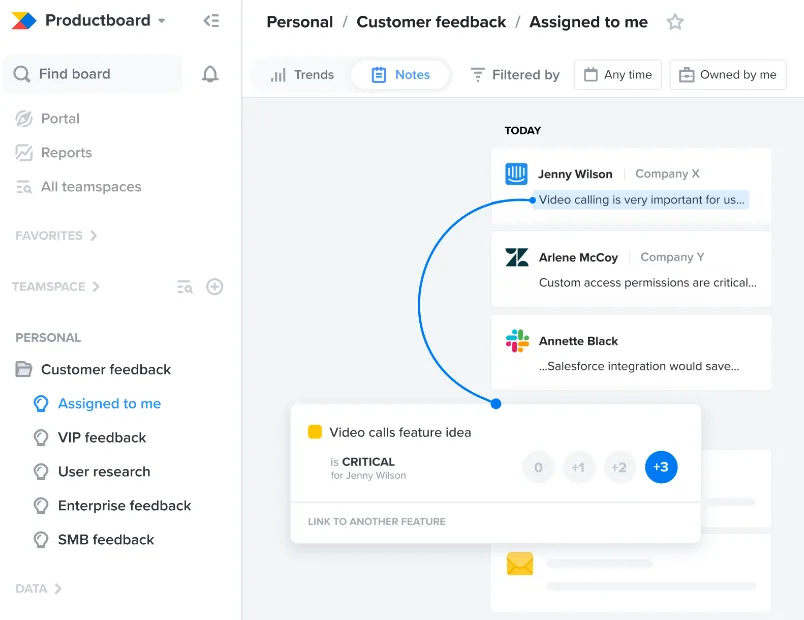
Productboard emerges as a comprehensive product management platform tailored for efficient feature prioritization and roadmap creation. Ideal for product teams, it centralizes product information and aids in constructing roadmaps that align with real user needs.
The strength of Productboard lies in its emphasis on feature prioritization and roadmap visualization, simplifying complex decision-making processes. Its standout features, such as the user feedback portal and prioritization matrix, facilitate streamlined product development and management.
Key Features & Integrations:
Distinguished features like a centralized feedback repository, feature scoring system, and visually appealing roadmaps make Productboard noteworthy. Additionally, it offers persona and segmentation tools catering to diverse user needs. Seamlessly integrating with prominent tools like Slack, Jira, Intercom, and Salesforce further enhances its utility.
Pricing Structure:
Starting price is $20/user/month (billed annually).
Pros:
- Excellent for feature prioritization and roadmap visualization
- Robust feedback management system
- Comprehensive integrations with various tools
Cons:
- Interface complexity may be overwhelming initially
- Higher-tier plans might be relatively costly
- Limited options for custom fields in certain plans
4. Contentsquare
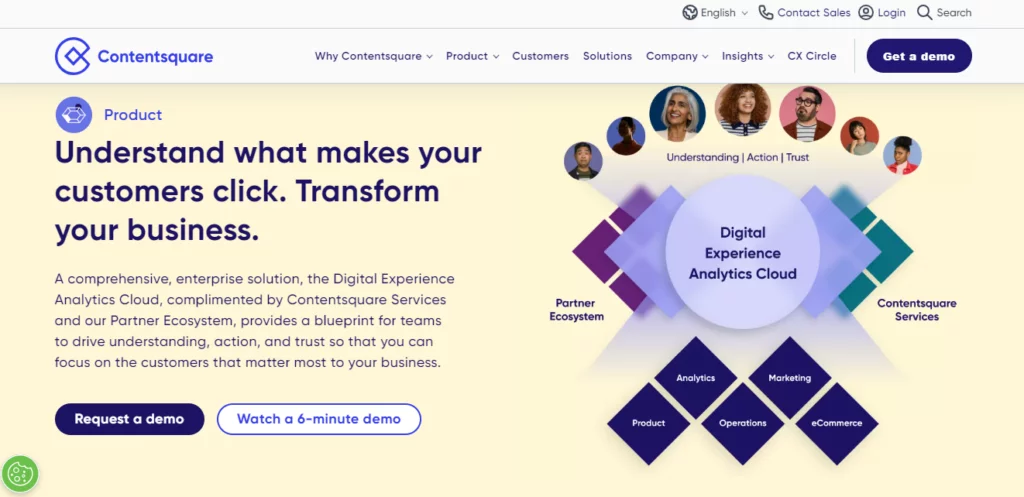
Contentsquare is a digital experience analytics platform designed to decode user interactions across apps, mobile, and websites. By employing visual analytics, it dives deep into user behaviors, providing unparalleled insights into user journeys.
Contentsquare’s unique focus on visually representing user interactions simplifies the identification of trends and anomalies within user behavior. This distinct visual journey mapping feature distinguishes it as the go-to tool for those aiming to enhance user journey insights using visual analytics.
Key Features & Integrations:
Dynamic features like heat maps, session replay, funnel analysis, and AI-powered insights empower users to explore the intricacies of user journeys comprehensively. It also offers actionable recommendations derived from captured data. Additionally, Contentsquare seamlessly integrates with Google Analytics, Adobe Analytics, and various marketing and analytics tools.
Pricing Structure:
Pricing details are available upon request.
Pros:
- Exceptional visual analytics capabilities
- Insightful visual user journey mapping
- Effective integration options with analytics tools
Cons:
- Lack of transparent pricing
- Complexity for beginners
- May require technical support for complete deployment
5. Jira
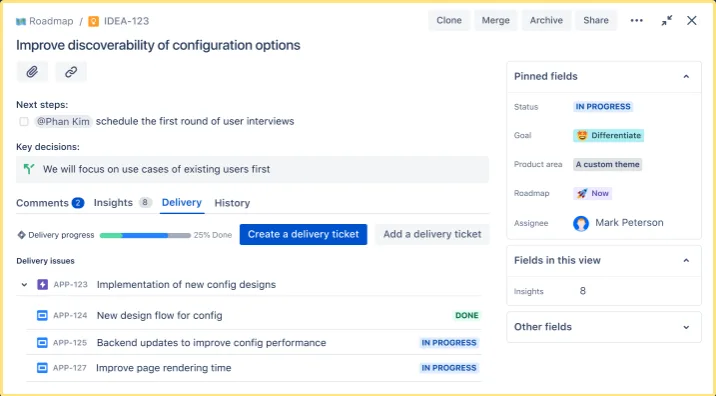
Jira, developed by Atlassian, stands as a prominent platform revered for its prowess in agile project management and software development. It acts as a robust hub, empowering teams to plan, track, and deploy cutting-edge software while embodying the agile methodology at its core
Jira earns its place due to its holistic approach to project management within software development landscapes. Offering a suite of tools that align with agile principles, it accommodates scrum, Kanban, or hybrid methodologies effortlessly. Jira is my top choice for its tailored features that cater specifically to agile project management and software development requirements.
Key Features & Integrations:
Jira encompasses customizable scrum boards, adaptable Kanban boards, roadmap planning, and advanced reporting tools for meticulous progress monitoring. Its seamless integration with other Atlassian tools such as Confluence and Bitbucket enhances its utility, while external integrations with platforms like Slack, GitHub, among others, further amplify its functionality.
Pricing Structure:
Jira’s pricing starts at $7/user/month, billed annually.
Pros:
- Comprehensive tool for agile project management
- Extensive integration capabilities with internal and external tools
- Advanced reporting functionalities
Cons:
- Steep learning curve for newcomers
- Interface could be more user-friendly
- Higher cost for larger teams
6. ProductPlan
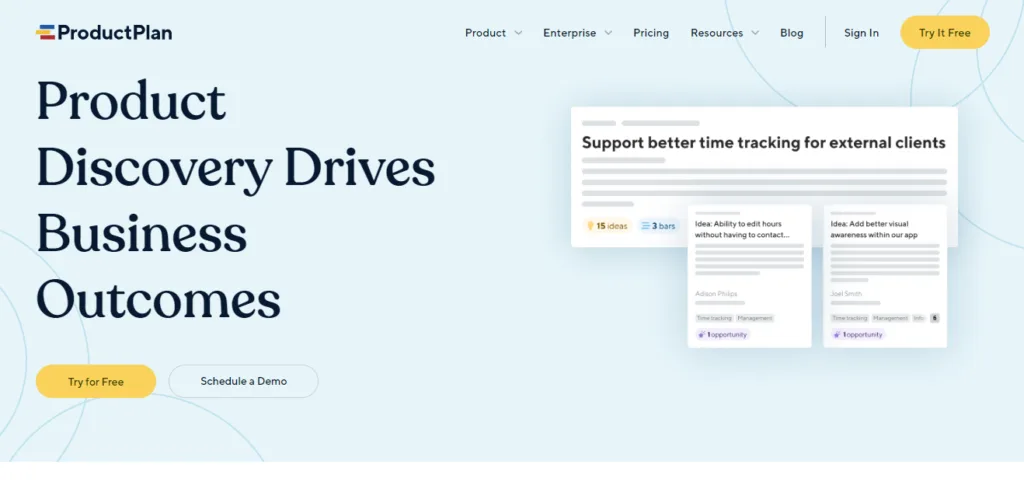
ProductPlan stands out as a dedicated roadmapping platform crafted to aid in strategic planning and clear visualization of product timelines. Its robust features empower users to define precise product strategies and communicate them seamlessly, particularly excelling in high-level strategic planning and visualization.
My choice of ProductPlan stems from its laser-focused approach to comprehensive strategic planning. Its ability to visually represent intricate product timelines distinguishes it in a crowded field. For teams requiring efficient roadmap visualization and strategic planning, ProductPlan is a prime selection.
Key Features & Integrations:
ProductPlan boasts roadmap creation, planning templates, goal setting, prioritization tools, and robust collaboration features. Its integrations encompass widely-used platforms such as Jira, Trello, Slack, and Microsoft Teams, facilitating effortless integration into existing workflows.
Pricing Structure:
ProductPlan starts at $39/user/month (billed annually).
Pros:
- Powerful visualization of product timelines
- Strong integrations with popular project management tools
- Efficient collaboration tools
Cons:
- Learning curve for interface navigation
- Lacks detailed project management features
- Higher pricing compared to some competitors
7. Segment
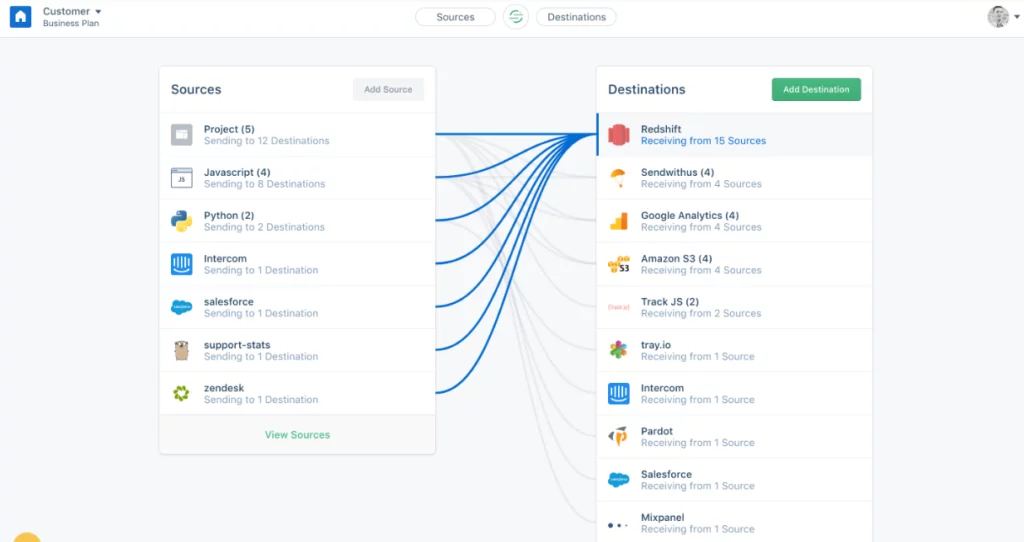
Segment serves as a data infrastructure platform specializing in the collection, storage, and routing of user data sourced from diverse channels to analytics tools. Its primary role in consolidating multifaceted user data positions it as an ideal solution for businesses seeking streamlined data management and utilization.
Key Features & Integrations:
Segment offers data tracking, API capabilities for streamlined data collection, audience segmentation, and real-time data access. It seamlessly integrates with an array of tools, including Google Analytics, Mixpanel, and Amplitude, amplifying its utility across diverse data environments.
Pricing Structure:
Segment’s pricing starts at $120/user/month.
Pros:
- Strong integrations with a multitude of tools
- Simplifies data management from various sources
- Provides real-time data access
Cons:
- Higher cost compared to some alternatives
- Some integrations may require technical expertise
- Limited customization options
8. Miro
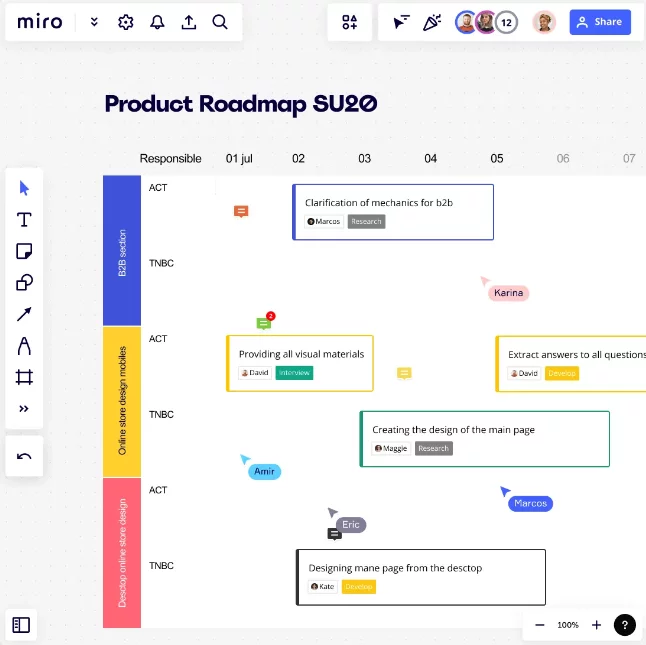
Miro serves as an online visual collaboration tool enabling teams to ideate and collaborate in real-time. Its emphasis on interactive visual collaboration makes it an exceptional choice for product teams engaged in brainstorming and ideation, regardless of their location.
Miro stands out for its real-time visual collaboration focus. With a rich set of drawing and diagramming tools, it supports a diverse array of brainstorming activities. Ideal for product teams seeking visual idea representation and collaborative brainstorming.
Key Features & Integrations:
Miro offers features like endless canvas, premade templates, real-time collaboration, and intuitive drawing tools. It integrates seamlessly with various productivity tools such as Slack, Google Drive, Dropbox, and Microsoft Teams, facilitating effortless incorporation into existing workflows.
Pricing Structure:
Starting at $8/user/month, billed annually.
Pros:
- Wide range of drawing and diagramming tools
- Excellent integrations with popular productivity tools
- Real-time collaboration and commenting features
Cons:
- Overwhelming for new users due to extensive features
- Relatively higher cost compared to some competitors
- Occasional performance lag reported during heavy usage
Selecting the Right UX Research Tools
As I navigated through over 20 UX research tools, I aimed to identify those that offer specialized features for comprehensive UX research. Here’s a breakdown of the criteria I considered essential for selecting the most valuable tools in this realm.
A. Core Functionality Criteria:
The ideal UX research tools should encompass:
- User Behavior Tracking and Analytics
- User Testing, accommodating remote and in-person sessions
- Survey Creation and Distribution Capabilities
- Efficient Feedback Collection and Management Systems
B. Key Feature Analysis:
Specific features I sought in these tools included:
- Heatmaps and Clickmaps: Visual representations highlighting user interactions to identify preferences and avoidances.
- Session Recording: Real-time playback of user interactions for a deeper understanding of behaviors.
- User Surveys: Capabilities for crafting and circulating surveys to gather direct user feedback.
- Feedback Analysis: Advanced analytics to derive actionable insights from user feedback.
- Integrations: Seamless compatibility with commonly used tools in your tech stack.
C. Usability Evaluation:
User-friendly functionality was a crucial aspect, considering:
- Intuitive Interface: Clear, organized, and navigable dashboards for data collection and analysis.
- Learning Curve: Accessibility even for non-technical users, backed by comprehensive guides.
- Customer Support: Responsive and knowledgeable support services for technical assistance.
- Customizability: Tailorable features to align with specific research objectives, enhancing tool efficacy.
Conclusion:
Selecting the most suitable UX research tool involves evaluating core functionalities, key features, and usability factors. Balancing robust capabilities with ease of use and adaptable features is key to finding the optimal fit for your research needs.
FAQs on UX Research Tools:
What distinguishes UX research tools from general analytics tools?
UX research tools are specialized in understanding user behaviors, preferences, and experiences, often offering visual representation features, user testing, and direct feedback collection, distinct from broader analytics tools focused on metrics and performance.
How important are integrations in UX research tools?
Integrations streamline workflows, allowing seamless data flow between tools. They enhance data accuracy and aid in consolidating insights, making them crucial for a cohesive research process.
Is it necessary to have comprehensive customer support with these tools?
Efficient and knowledgeable customer support ensures smoother operations, especially in handling technical issues or utilizing advanced features. It can significantly impact the user experience.
Can these tools adapt to diverse research methodologies?
The best tools offer flexibility, accommodating various research approaches—quantitative and qualitative—and allowing customization to align with distinct methodologies.



